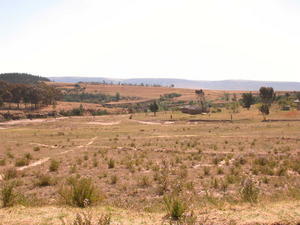Advertisement
Published: November 3rd 2006

 Lesotho landscape
Lesotho landscape
The drive to Thaba Bosiu was beautiful.One our first trips into the country was to visit Thaba Bosiu, the hilltop fortress that was used by King Moshoeshoe to resist the Zulu invaders in the 1820’s. Moshoeshoe was a great ruler and diplomat who welcomed and offered assistance to all of the varied peoples who sought refuge from the invading Zulu. Within a short period of time, his small band had expanded to a considerable number, which he united under the Basotho banner to form Basutoland, later called Lesotho. The site at Thaba Bosiu repelled many assaults, at first from the Zulu and later from the Boers. Moshoeshoe’s grave is atop Thaba Bosiu, which is regarded as one of the most important historical sites in Lesotho. We wanted to walk to the top, but we ended up not having time.
Today was the third day of the annual National Arts and Culture Festival in Morija. We spent all three days at the festival where we worked in the Bahá’í information booth (tent). Morija was the first site that Moshoeshoe permitted missionaries to occupy in Lesotho, and the French set up a Catholic mission there. The festival was full of great music, including traditional, gospel and rock, and
traditional dancing.
In order to create more activity at the Baha'i booth, Sherri and I offered to paint children’s faces. It took us some time to find brushes and a non-toxic paint we could use but we finally managed. On Thursday we went to set the booth up, which also happened to be a special day at the festival for school children, all of whom stared at us, as we happened to be the only two white faces at the festival grounds. The following day we began painting faces but had very few customers until we painted the face of Kal’s stepdaughter, Happe, and other children saw an example of our work. We informed them that we would paint their faces for the cost of zero cents. The first children were very shy and would only talk to us in a whisper. It became apparent to us that many of them had never been touched by a white person before,and many of the younger ones didn't speak English. Many of the children we painted the first day, however, returned the following day and brought their friends with them. Before long we had more kids in the booth than we
could begin to paint, and we had recruited a local Bahá’í to help us. What wonderful faces they were to paint! It was so much fun for us and for them. In three days we had painted hundreds of faces, and there had been a distinct change in the attitude of the children. Many of them now smiled and waved when they saw us, and they began to speak to us more freely. They became much more comfortable with us, and some asked us when we would return to Morija. If the event is held next year, we will certainly try to return.
The landscape of Lesotho is a great deal like the American southwest. The country is also a lot like what the American west was like in the 1880’s with many shepherds and cattlemen who ride horses. It is common to see people wrapped in the traditional Lesotho blanket and wearing the straw hat that is very much a symbol of the country. During the festival, groups wore the brightly colored wool blankets to denote what part of the country the wearer was from.
An unfortunate side effect of being around all those wonderful children is

 erosion landscape
erosion landscape
In quite a few places we saw significant erosion, as the land is very over-grazed.that this morning I woke up with the beginnings of an icky cold.
Advertisement
Tot: 0.093s; Tpl: 0.024s; cc: 8; qc: 52; dbt: 0.0511s; 1; m:domysql w:travelblog (10.17.0.13); sld: 2;
; mem: 1.2mb

 Lesotho landscape
Lesotho landscape
 erosion landscape
erosion landscape















Khotso Rats'iu
non-member comment
macufe
I'll first like to pose a question: is the annual arts and cultural festival used to be held in morija going to be held in thaba-bosiu? this came to my recognition that festival will be fully culltural if it were held in thaba-bosiu, and i often hear many people assuming that this is going to be the case, is that true?